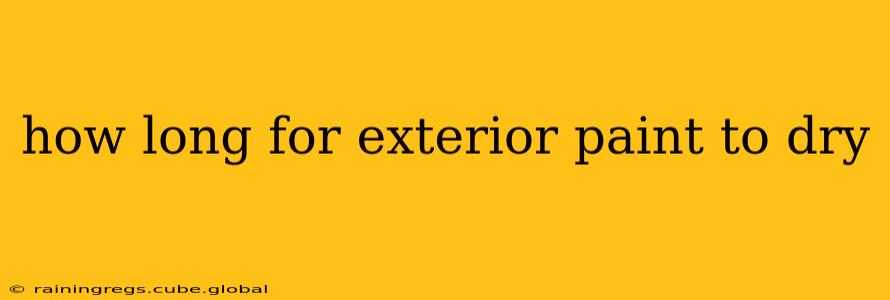Choosing the right exterior paint and understanding its drying time is crucial for a long-lasting, beautiful finish. The drying time isn't a simple answer, as it depends on several factors. This guide will break down the process, helping you avoid common mistakes and achieve professional results.
Understanding Paint Drying Stages
Exterior paints typically go through two main drying stages:
- Surface Dry: This is when the paint feels dry to the touch. You can usually walk on it without leaving footprints after surface drying.
- Cured: This is when the paint is fully hardened and chemically bonded, offering complete weather and UV resistance. It's crucial to wait until the paint is fully cured before exposing it to rain or intense sunlight.
How Long Until It's Surface Dry?
The surface dry time for exterior paint usually ranges from 4 to 8 hours, depending on:
- Paint Type: Oil-based paints generally take longer to dry than water-based (latex) paints.
- Temperature: Warmer temperatures accelerate drying, while cooler temperatures slow it down. Ideal temperatures for painting are generally between 50°F and 90°F (10°C and 32°C).
- Humidity: High humidity increases drying time. Low humidity allows for faster drying.
- Thickness of Application: Thick coats take significantly longer to dry than thin coats. Multiple thin coats are generally recommended for better adhesion and coverage.
- Paint Color: Darker colors absorb more heat, potentially leading to faster surface drying, but this doesn’t necessarily mean faster curing.
- Ventilation: Good air circulation speeds up drying.
How Long Until It's Fully Cured?
Full curing time for exterior paint typically takes 24 to 72 hours, sometimes even longer, depending on the factors listed above. It's essential to check the paint manufacturer's instructions, as they will provide the most accurate timeframe for the specific paint you are using. Ignoring the curing time can lead to damage, chipping, and reduced paint longevity.
What Happens If It Rains Before the Paint is Dry?
Rain before the paint is fully cured can significantly impact the final result. The rain can wash away the paint, causing unevenness, streaks, and a weak finish. In severe cases, it may require repainting. Always check the weather forecast before starting an exterior painting project and ensure you have enough time for proper drying.
Can I Speed Up the Drying Process?
While you can't drastically alter the chemical process, you can optimize conditions to speed up the drying time:
- Choose the right paint: Opt for paints designed for faster drying.
- Apply thin coats: Avoid applying excessively thick coats.
- Improve ventilation: Ensure good airflow around the painted surface.
- Paint on a warm, dry day: Favor lower humidity and optimal temperatures.
What if My Exterior Paint is Still Tacky After 24 Hours?
If your exterior paint remains tacky beyond the manufacturer's recommended drying time, there might be underlying issues:
- Excessive humidity: Check the humidity levels and postpone further painting until conditions improve.
- Incorrect application: Improper mixing or application techniques could affect drying.
- Low-quality paint: Using inferior paint can lead to extended drying times.
Remember to always follow the manufacturer's instructions on your chosen paint, as these will provide the most accurate drying times and application advice specific to your product. Always prioritize quality paint and proper application techniques for a long-lasting and beautiful finish.
